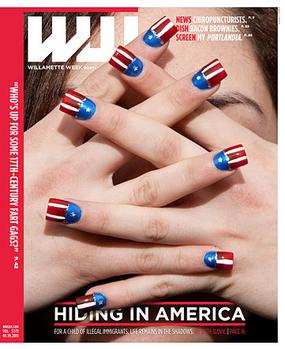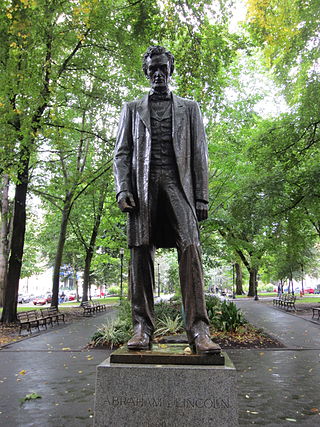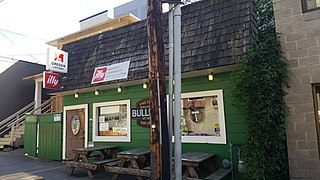
Portland is a port city in the Pacific Northwest and the most populous city in the U.S. state of Oregon. Situated in the northwestern area of the state at the confluence of the Willamette and Columbia rivers, Portland is the county seat of Multnomah County, the most populous county in Oregon. As of 2020, Portland had a population of 652,503, making it the 26th-most populous city in the United States, the sixth-most populous on the West Coast, and the second-most populous in the Pacific Northwest, after Seattle. Approximately 2.5 million people live in the Portland–Vancouver–Hillsboro, OR–WA metropolitan statistical area, making it the 25th most populous in the United States. About half of Oregon's population resides within the Portland metropolitan area.

The Oregonian is a daily newspaper based in Portland, Oregon, United States, owned by Advance Publications. It is the oldest continuously published newspaper on the U.S. West Coast, founded as a weekly by Thomas J. Dryer on December 4, 1850, and published daily since 1861. It is the largest newspaper in Oregon and the second largest in the Pacific Northwest by circulation. It is one of the few newspapers with a statewide focus in the United States. The Sunday edition is published under the title The Sunday Oregonian. The regular edition was published under the title The Morning Oregonian from 1861 until 1937.

Willamette Week (WW) is an alternative weekly newspaper and a website published in Portland, Oregon, United States, since 1974. It features reports on local news, politics, sports, business, and culture.

Downtown Portland is the central business district of Portland, Oregon, United States. It is on the west bank of the Willamette River in the northeastern corner of the southwest section of the city and where most of the city's high-rise buildings are found.

Mount Tabor is a neighborhood in Southeast Portland that takes its name from the volcanic cinder cone and city park on the volcano that it surrounds, in the U.S. state of Oregon. The name refers to Mount Tabor, Israel. It was named by Plympton Kelly, son of Oregon City pioneer resident Clinton Kelly.

The history of the city of Portland, Oregon, began in 1843 when business partners William Overton and Asa Lovejoy filed to claim land on the west bank of the Willamette River in Oregon Country. In 1845 the name of Portland was chosen for this community by coin toss. February 8, 1851, the city was incorporated. Portland has continued to grow in size and population, with the 2010 Census showing 583,776 residents in the city.

Harvey Whitefield Scott (1838–1910) was an American pioneer who traveled to Oregon in 1852. Scott was a long-time editorialist, and eventual part owner of The Oregonian newspaper. Scott was regarded by his contemporaries as instrumental in bringing the state of Oregon firmly into the political camp of the Republican Party.

Darcelle XV Plaza is a square that was a small park and fountain at the intersection of Southwest Park Avenue and Southwest Harvey Milk Street in downtown Portland, Oregon, in the United States. It received the current name in July 2023. It was named after Hugh O'Bryant, Portland's first mayor.

Mount Tabor is an extinct volcanic vent with a city park on the volcano, located in Portland, Oregon's neighborhood of the same name. The name refers to Mount Tabor, Israel. It was named by Plympton Kelly, son of Oregon City pioneer resident Clinton Kelly.

Thompson Elk Fountain, also known as the David P. Thompson Fountain, David P. Thompson Monument, Elk Fountain, the Thompson Elk, or simply Elk, is a historic fountain and bronze sculpture by American artist Roland Hinton Perry. The fountain with its statue was donated to the city of Portland, Oregon, United States, in 1900 for display in Downtown Portland's Plaza Blocks. It is owned by the City of Portland.

A bronze statue of Abraham Lincoln by George Fite Waters was installed in Portland, Oregon's South Park Blocks, in the United States, until 2020. The 10-foot statue was donated by Henry Waldo Coe.

Vera Katz, also known as Mayor, Vera Katz, is an outdoor bronze sculpture depicting Vera Katz created by American artist Bill Bane. Unveiled in 2006, it is located along the Eastbank Esplanade in Portland, Oregon. Katz, a former mayor of the city between 1993 and 2005, supported arts and culture during her tenure and established Oregon's Percent for Art program. She was also instrumental in developing the Eastbank Esplanade, which is named after her. The sculpture has received a mostly positive reception and has inspired people to adorn it with clothing, flowers and makeup.

A 1926–27 statue of George Washington by Italian American artist Pompeo Coppini was installed in northeast Portland, Oregon, United States. The bronze sculpture was the second of three statues of Washington by the artist, following a similar statue installed in Mexico City in 1912 and preceding another installed on the University of Texas at Austin campus in February 1955. The Portland statue was created to commemorate the 1926 sesquicentennial of the Declaration of Independence and dedicated in 1927. It was part of the City of Portland and Multnomah County Public Art Collection courtesy of the Regional Arts & Culture Council. In June 2020, it was toppled by protestors.

A bronze sculpture of American pioneer, newspaper editor and historian Harvey W. Scott (1838–1910) by Gutzon Borglum, sometimes called Harvey Scott or Harvey W. Scott, was installed on Mount Tabor in Portland, Oregon, United States, until being toppled in October 2020.

New Copper Penny was a nightclub located at the intersection of Southeast 92nd Avenue and Foster Road in Portland's Lents neighborhood, in the U.S. state of Oregon.

The End Domestic Terrorism rally, sometimes subtitled "Better Dead Than Red", was a far-right demonstration organized by the Proud Boys and held in Portland, Oregon on August 17, 2019. The event, the purpose of which was to promote the idea that the "antifa" anti-fascist movement should be classified as "domestic terrorism", received national attention. The rally drew more counter-demonstrators than participants, with at least one group urging its members in advance not to attend, and ended with the Proud Boys requesting a police escort to leave.

Starting in May 2020, protests following the murder of George Floyd were held in the city of Portland, Oregon, concurrent with protests in other cities in the United States and around the world. By July 2020, many of the protests, which had been held every day since May 28, drew more than 1,000 participants. Protests continued into August, September, and October 2020, often drawing hundreds.

Cheerful Bullpen is a pub in Portland, Oregon, United States.

The Belmont Inn, or simply Belmont's, is a bar along Belmont Street in the district of the same name within southeast Portland, Oregon's Sunnyside neighborhood. Owned by Seth Leavens, the bar has pool, darts, a jukebox, and video poker.























